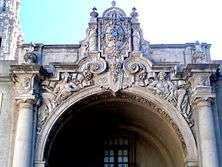Piccirilli Brothers
The Piccirilli Brothers were a family of renowned marble carvers and sculptors who carved a large number of the most significant marble sculptures in the United States, including Daniel Chester French’s colossal Abraham Lincoln (1920) in the Lincoln Memorial, Washington, D.C.
History
In 1888, Giuseppe Piccirilli (1844–1910), a well-known stone carver and a veteran of Garibaldi's Unification war, brought his family to New York City from Massa di Carrara, in Tuscany, Italy. The entire family, father and six sons—Ferruccio (1864– ), Attilio (1866–1945), Furio (1868–1949), Masaniello (1870–1951), Orazio (Horatio) (1872–1954) and Getulio (1874–1956)—were trained as marble cutters and carvers.
Although the Piccirilli Brothers were known primarily as architectural modelers and the carvers of other sculptors’ works, Attilio and Furio would further distinguish themselves as sculptors in their own right.
The family lived in a brownstone on 142nd Street in the Mott Haven section of the Bronx and set up a workshop next to their home that would eventually occupy an entire city block.
At that time most prominent sculptors would create their original work in clay. From that clay model a caster would generate a plaster model. The model would then be sent to the Piccirilli Brothers who would carve it from stone, typically marble, although limestone and granite were also used. The brothers became the carvers of choice for a large number of American sculptors of the time including Daniel Chester French and Paul Wayland Bartlett.
Besides their work as carvers the Piccirilli Brothers also created architectural detailing and embellishments for a large number of public and private buildings.
One of the great losses in American art history occurred when the Piccirilli Brothers studio quietly closed its doors and no move was made to secure their records, so the accounts of much of what they had accomplished was lost.

Original sculpture by the Piccirilli Brothers
- USS Maine National Monument, H. Van Buren Magonigle, architect, Atillio Piccirilli, sculptor 1913; Columbus Circle, New York City.
- Firemen's Memorial, H. Van Buren Magonigle, architect, Atillio Piccirilli, sculptor figures of Courage and Duty 1913: Riverside Park at 100th Street, New York City
- Much of the stonework on the California State Building and the attached buildings at the Panama-California Exposition (1915).
- Manitoba Legislative Building, 1919, Simon and Boddington, architects, figures of Sieur de La Vérendrye and Lord Selkirk, plus many architectural figures and details, Winnipeg, Manitoba
- Riverside Church, Riverside Drive, NYC 1931
Selected works carved for other sculptors
- U.S. Custom House, [1907], Cass Gilbert, architect, The Four Continents, Daniel Chester French; and twelve allegorical statues on the cornice by Charles Grafly, Frederick Ruckstull, Augustus Lukeman, and others, at Bowling Green, NYC;
- N.Y. Stock Exchange pediment [1903], John Quincy Adams Ward and Paul Bartlett, sculptors, George B. Post , architect, Wall Street, NYC.
- "Apotheosis of Democracy" [1919] for the pediment of the House wing of the United States Capitol, Paul Bartlett, sculptor, Thomas U. Walter, architect, Washington D.C.
- Pediment and thirty large allegorical figures for the cornice of the Brooklyn Museum, [1913], Daniel Chester French, Adolph Alexander Weinman, Augustus Lukeman, Karl Bitter, Charles Keck, Janet Scudder, Herbert Adams, Carl Heber and others, sculptors, McKim, Mead, and White, architects, Brooklyn, NY.
- The New York Public Library, [1916] Carrère and Hastings, architects, where they executed two pediments by George Grey Barnard, six 11-foot-tall (3.4 m) cornice figures including Poetry, Drama, and History, by Paul Wayland Bartlett and the two lions by Edward Clark Potter, which have come to represent the NY Library .
- Washington Arch, Stanford White, architect, [1918] figures by Frederick MacMonnies, Hermon Atkins MacNeil, and Alexander Stirling Calder, Washington Square, NYC
- DuPont Circle Fountain, [1921], Daniel Chester French, sculptor, Henry Bacon, architect, Washington D.C.
- Civic Virtue Fountain, 1922. by Frederick MacMonnies, originally created for City Hall Park, was moved in 1941 to Queens Borough Hall and then in 2012 to Green-Wood Cemetery.
- Tomb of the Unknowns, aka Tomb of the Unknown Soldier, Arlington National Cemetery, 1931
- Past, Guardians of the Portals and Future, for Robert Aitken at the National Archives Building, Washington D.C.
See also
References

- Baker, Marilyn, Manitoba’s Third Legislative Building: Symbols in Stone: The At and Politics of a Public Building, Hyperion Press Limited, Winnipeg, Manitoba 1986
- Balfour, Alan, Rockefeller Center – Architecture As Theater, McGraw-Hill Book Company, NY, NY 1978
- Bogart, Michele H., Public Sculpture and the Civic Ideal in New York City: 1890–1930, University of Chicago Press, Chicago 1989
- Contemporary American Sculpture Issued for the Exhibition held by the National Sculpture Society in Cooperation with the Trustees of the California Palace of the Legion of Honor, MCMXXIX, National Sculpture Society, NY 1929
- Gardner, Albert Ten Eyck, American Sculpture: A catalogue of the Collection of the Metropolitan Museum of Art, The Metropolitan Museum of Art, 1965
- Kvaran, Einar Einarsson and Walt Lockley, Guide to Architectural Sculpture in America, unpublished manuscript
- Lombardo, Josef Vincent, Atilio Piccirilli: Life of an American Sculptor, Pitman Publishing Corporation, New York 1944
- Reynolds, Donald Martin, Monuments and Masterpieces; Histories and views of Public Sculpture in New York City, Macmillan Publishing Company, New York 1988
- Somma, Thomas P. The Apotheosis of Democracy, 1908–1916: The Pediment for the House Wing of the United States Capitol, University of Delaware Press, Newark 1995
- The Riverside Church in the City of New York: A Handbook of the Institution and Its Buildings, The Rivrsude Church, New York 1931
External links
- Piccirilli Brothers
- Piccirilli Brothers This website contains information about the Brothers' works throughout New York City and the nation.